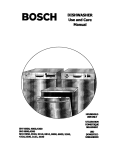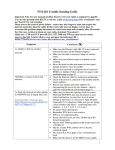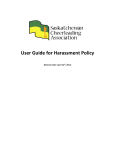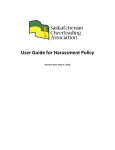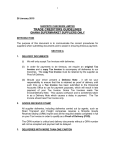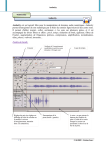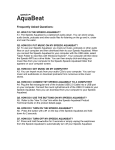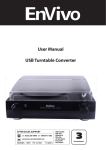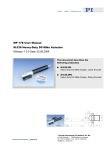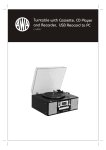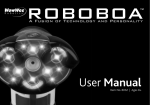Download My Music - Bowland Maths
Transcript
My Music a mathematical investigation Carla Finesilver My Music Introduction to 'My Music' Overview Listening to music is frequently cited by young people as one of their main pastimes, and the music industry is often of interest to them as a potential career choice. Many young people also have strong opinions about different types of music, with favourite genres and artists. My Music utilises this keen interest in music to provide the opportunity for mathematical investigations, by using students' own favourite music as raw data. They make hypotheses about the similarities and differences between genres of popular music, with particular focus on tempo. They then analyse their music statistically to find out if their hypotheses are correct. Throughout the project, there are opportunities to address a variety of mathematical topics and issues; it is up to the teacher to decide which of these they wish to pursue with a particular class, and whether they wish to use the tasks to put into practice previously taught skills and knowledge, or as a 'springboard' from which to teach new material. My Music is a highly flexible project, in which the mathematical content and practical activities may be moulded to suit students of almost any age or ability. Mathematical content The case study is in two parts. Part 1 has two main objectives: (a) to illustrate or utilise a variety of statistical concepts, terms and procedures, embedded within a practical context; and (b) to introduce students to the process of planning and carrying out an open-ended investigation. Part 2 uses a similar context, task and materials to focus in more depth on rates of change and measurement. The majority of subject content falls under National Curriculum Section 3.3: Statistics. The only essential prerequisite for students is a grasp of arithmetic, although the project works particularly well if they have some prior experience in working with averages, and with basic data collection and representation. The main thrust of My Music addresses the nature of data and the concept of variables, in terms of the characteristics of individual pieces or genres of music. Investigations focus on tempo, as a measurable variable. The project can work as an introduction to statistical project-work, including the collection of numerical data (working out the BPM of music samples), performing basic statistical calculations (e.g. average and range of tempos) and interpreting the results, forming and testing hypotheses (based on a sample of music tracks) and making inferences about a population (i.e. comparing genres of music). However, there are also opportunities to focus on several other areas, such as the nature of compound measures (e.g. beats per minute), factors and multiples, and identifying potential sources of error in data collection and calculations. Organisation and pedagogy My Music includes both group work (preferably pairs or threes) and teacher-led whole-class activity. In both cases there is a mixture of practical activity and discussion. Homework may be set either to groups or to individual students. The suggested time allowance is 4 lessons for Part 1 and 2 for Part 2, although with some classes it is possible to shorten this. The project may be done in a block of consecutive maths lessons, or spread out over a longer period (for example, one My Music lesson per week). This latter may be appropriate if there is limited access to computers or audio equipment. My Music would work particularly well as a cross-curricular project with the involvement of the music department, although it does not require any specific musical skills or knowledge. 2 My Music Resources Equipment For the first lesson of Part 1, teachers will need the starter tracks provided, some music tracks of their own, and a means to play them to the class. These will most likely be music tracks in mp3 or CD format, plus a computer with speakers. For the next lesson, students will need to bring in their own music, to listen to in groups or pairs. Some will have their own portable music devices, but for others, teachers will need to provide listening equipment, most likely by booking a set of laptops or a computer suite. Similarly, not all students will have their own headphones, so some may need to be borrowed from the music department. Audio splitters are ideal for the practical group work, or if the school does not have these, students could share one set of headphones between two, with one earpiece each. Part 2 may be done immediately after Part 1, at a later point in the school year, or (if time is very limited) omitted entirely. It requires one computer for each group of students, plus headphones etc. Computers need to be loaded with the Audacity software (or any similar audio-editing package). It is very helpful if teachers have access to an interactive whiteboard or data projector for demonstration. Teaching pack p4 Overview p6 KS3 National Curriculum links p7 Cross-curricular links to the National Curricula for Music and ICT p8 Lesson plans providing an outline of the themes and activities for each lesson p14 Supplementary teaching notes providing more detailed notes on pedagogical issues – particularly recommended for less experienced teachers and non-musicians p21 Music support p23 ICT support p25 Student sheets, some or all of which the teacher may choose to use p35 Credits A set of 'BPM starter tracks' is included for the first lesson, but whole songs are not provided (for reasons of copyright). A back-up data set of BPM information for 48 songs from 1960-2007 is provided in spreadsheet format. The Audacity software is also bundled with the CD ROM version of the project, distributed under the GNU General Public License. 3 My Music Overview of activities and mathematical content The case study is extremely flexible in terms of structure. This teaching/learning plan is presented in two parts, Part 1 of which is intended to correspond to approximately 4 hours of lesson time, but could be more or less, depending on what the teacher decides is appropriate for their particular class. The time allocation for Part 2 (and indeed whether it is included at all) depends greatly on the resources available to the school, and is equally flexible, but an allowance of 2 hours is suggested. The main intended mathematical content is shown in bold, with additional suggestions of concepts which the teacher may wish to include. Part 1 Lesson 1: Introduction Discussion of musical genres ● ● ● Discussion of tempo ● ● ● Beats per minute (BPM) calculations Concept of variables Types of variables (quantitative or qualitative, objective or subjective, countable, measurable, etc.) The use of variables for categorisation Construction of a compound unit of measurement Rates of change Choice of appropriate units of measurement ● Data collection ● Mean, median, range, etc. ● Factors and multiples ● Accuracy and errors in data collection ● Estimation Lesson 2: Investigation Investigating tempo ● ● Planning an investigation ● Working systematically ● ● 4 Forming testable hypotheses or suitable questions to investigate Accurate recording of data collected and BPM calculations Choice of appropriate statistical calculations My Music Lesson 3: Representation and analysis Discussion of data collected, representation and analysis ● Identifying errors in data ● Interpretation of results ● Graphical display of data ● ● Thinking critically about the investigational process Representative sampling and randomness Lesson 4: Presentation Presentation of work from previous lessons ● ● Explanation of findings Coherent and structured communication of the investigation process, results and conclusions Part 2 Lesson 1: Introduction Discussion of the effects of changing tempo ● ● Audio editing ● Relationship between measures of tempo and time periods Mathematical ways of describing change (of tempo) Using software to make mathematical changes to audio files Lesson 2: Investigation Investigating tempo changes ● 5 Working systematically and recording actions ● Estimation ● Calculations involving time ● Percentage increase/decrease My Music KS3 National Curriculum links Key concepts Opportunities for increasing students' Competence (1.1 a-c), Creativity (1.2 a-c), understanding of the Applications and implications of mathematics (1.3 a-d) and Critical understanding (1.4 a-b). Key processes Opportunities for students to work on their skills in Representing (2.1 a-d), Analysing (2.2 a-p), Interpreting and evaluating (2.3 a-g) and Communicating and reflecting (2.4 a-e). Range and content 3.1 Numbers and algebra (b) Rules of arithmetic applied to calculations and manipulations with rational numbers (c) Applications of ratio and proportion (d) Accuracy and rounding 3.2 Geometry and measures (g) Units, compound measures and conversions 3.4 Statistics (a) The handling data cycle (b) Presentation and analysis of grouped and ungrouped data [. . .] (c) Measures of central tendency and spread Curriculum opportunities This project is designed to be in line with all the opportunities suggested in the KS3 National Curriculum guidelines (4 a-g). 6 My Music Cross-curricular links: Music Key concepts 1.3 (a) Engaging with and analysing music, developing views and justifying opinions 1.3 (b) Drawing on experience of a wide range of musical contexts and styles to inform judgements 1.4 (a) Using existing musical knowledge, skills and understanding for new purposes and in new contexts 1.4 (b) Exploring ways music can be combined with other art forms and other subject disciplines Key processes Opportunities for students to: 2.2 (a) analyse, review, evaluate and compare pieces of music Range and content 3 (f) Use of music technologies to create, manipulate and refine sounds Cross-curricular links: ICT Key concepts 1.1 (c) Applying ICT learning in a range of contexts and in other areas of learning, work and life 1.5 (b) Reviewing and reflecting critically on what they and others produce using ICT Key processes Opportunities for students to: 2.2 (a) [. . .] use ICT tools and techniques appropriately, safely and efficiently Curriculum opportunities 4 (e) Share their views and experiences of ICT, considering the range of its uses and its significance to individuals, communities and society 4 (f) Use ICT in other subjects and areas of learning with contexts that are relevant and interesting to them 7 My Music Lesson Plans for Part 1 This section contains outline lesson plans, based on 4 one-hour lessons. For more detailed discussion of pedagogical issues arising during the project, please refer to the Supplementary Teaching Notes. Less experienced teachers are advised to read through these before starting the project. Suggested prompts are in italics. SS refers to the student sheets. All homework tasks are optional. Lesson 1: Introduction Discussion: What are musical genres? Notes Initiate discussion of types of popular music, and the ideas of classification and genre. Make brief notes on students' musical preferences. What are the characteristics of different genres? How do you know that a music track is of one genre rather than another? Listening activity: Variables to define genres Resources Play two contrasting music tracks to the class. Students describe the tracks, and identify differences and similarities between them. SS 1 Introduce the idea of using variables to describe music, and make a list with the class of such variables (e.g. tempo, dynamic range, vocal style, instrumentation, etc.) Direct students to think about the characteristics of the variables suggested. --Two music tracks (teacher's own) of contrasting style Which variables are objective and which opinion-based? Are they qualitative or quantitative? Which are measurable? Experiment: Music and heart rate Resources Direct students' attention to one particular variable: tempo. Encourage them to think about why types of music are faster or slower than others. SS 2 Who listens to it? Where is it played? Do people dance to it? Discuss whether listening to different types of music might affect people's moods. Hypothesis: “Fast music is exciting, and slow music is relaxing.” How could this 'hypothesis' be tested? Suggest an experiment to test the effect of listening to fast and slow music on listeners' heart rates (if students have not suggested this themselves). Play two tracks, one very slow and one very fast; students take their pulse before and after each. Discuss results, make appropriate calculations and look for patterns. If there are anomolous results, discuss what might have caused this. What other factors might have affected the results (e.g. expectations)? [Lesson 1 continued overleaf] 8 --Two music tracks (teacher's own), one slow and one fast --Stopwatch or clock My Music Discussion: The pulse of music Resources Use the analogy of heartbeats and 'taking the pulse' to introduce the idea of having a numerical value for the tempo of music. Explain the process of counting beats and calculating the BPM, i.e. the number of beats per minute (if students do not suggest this themselves). An example of a tempo marking, e.g. Emphasise that although the vast majority of music has a pulse, it can in some cases be difficult to locate and/or measure it. Highlight the fact that any kind of measure of rate of change will use compound units (e.g. m/s, mph, etc.), and that these units of measurement are generally constructed from two simple units. Listening activity: Taking the pulse of music Resources Play one or more examples of drum tracks to the class. Draw students' attention to the 'pulse', by waving a hand in time or tapping the desk, and encourage students to do the same. SS 3 Help students learn to calculate the BPM [see Supplementary Teaching Notes for more detail]. For each track, allow it to play for a while, giving students a chance to find the pulse, then say 'start' and 'stop' to indicate the counting period. Move on to 'groove' tracks – play one or more examples to the class, until they seem confident at finding the beat and calculating the BPM. Finally, calculate the BPM of one or more real music tracks. Choose ones which have a very obvious beat [see Music Support]. --Drum and groove tracks --Selection of 'real' music tracks with a clear, constant beat Discuss any variations in the answers given by students, and the possible reasons for variation. Preparation for investigation Notes Review main points covered in the lesson. Decide how to organise groups: in friendship groups or by ability, musical taste, etc. Inform students that next lesson they will be working in groups to investigate the tempo of their own choice of music. Remind them that they must bring in some music in order to take part in the activity, it must be appropriate for use in school, and should preferably have a clear, constant beat. Give examples of some possible hypotheses or questions about music. “Which are the fastest and slowest genres?”, “The tempo of rock music varies more widely than dance music”, “Music has become steadily faster over the years”, “Chart Number Ones have a higher than average BPM”, “Musicians make slower music as they get older”, etc. Organise students into appropriate groups, and allow them the remainder of the lesson for planning their investigation. If unsure, they should choose either a particular genre to investigate, or a particular artist/band. Homework: Think of some hypotheses which could be tested. Choose some music to bring in to school for the next lesson. 9 --If the school does not have a class set of headphones, remind students to bring their own. --Find out which physical format students use for music (CDs, MP3 player, etc.) My Music Lesson 2: Investigation Group activity: Investigating tempo Resources Each group decides on the hypothesis or question they wish to investigate, and chooses a selection of music tracks. This might involve focusing on a particular genre, band or artist. SS 4 For each track, they first estimate the BPM, then calculate it as accurately as possible. It is suggested they take multiple readings of the same track to improve reliability of results. If the readings are close together, they could take an average; if one result is significantly different from the others, it may be identified as a probable error. Remind students to work out the BPM using the (15 seconds x 4) method, and not to listen to the whole length of the track each time! Have a stock of additional music (perhaps a few albums), as there may be some groups who have forgotten to bring music of their own. Homework: Students calculate the BPM of a selection of music tracks chosen by their parents/guardians. --Music-playing devices --Headphones (and splitters if available) --Stopwatches (if available) --Spare music tracks Extension tasks (if needed) Resources/Notes Some options: Second copy of SS 4 for some groups ● ● ● ● ● The group picks a second genre, band or artist, repeats the investigation and makes a comparison between the two sets of data. Combine two groups who have investigated different genres (e.g. pair a rock group with an R'n'B group), and direct them to compare and contrast their results. The group broadens out their focus to investigate a different variable within their set of music tracks, such as a particular time period (e.g. “popular songs this year”), country of origin, chart position, number of copies sold, etc. The group investigates further the distribution of BPMs on albums. How much variation in tempo does there tend to be in a single album? Are there 'outliers' (i.e. one or two slow tracks on a generally fast album), and where in the track listing do they occur? The group investigates other quantitative variables in their chosen music, e.g. the length (time) of songs. Do songs of different genres tend to be of different lengths? How much variation is there in the length of songs by the same artist or band? Have average song lengths changed over the years? 10 --Further information on music tracks can often be found on the CD covers, or in the metatags of tracks which are in electronic format. My Music Lesson 3: Representation and analysis Class activity: Combining, representing and analysing data Resources Gather together results from the different groups to produce a larger data set for discussion, display and analysis. The aim of this is to ensure conscious engagement with the data and draw out as much meaning as possible from the students' statistical calculations. SS 5 Encourage students to reflect critically on the data, how it was collected, whether it is representative, biased, etc. Ask groups for the conclusions from their investigations. These can then form the basis for new hypotheses, which can be tested statisticually using the new whole-class data set. --Representational tools as appropriate, e.g. computers, number line --Back-up data set Some options: ● ● Ask students for examples of the BMPs they have calculated. Type these into a spreadsheet on interactive whiteboard. Means, medians and ranges of the whole data set or of subsets may be calculated. Students compare the new results with those from their own previous group work and decide whether the new data confirms or denies their conclusions. Set up a large visual representation to which students can add their results (e.g. put a large number line on the board/wall, with students sticking on coloured counters to represent the BPM of each data point). This makes it easier to see the shape of the distribution. There will probably be cluster effects for some genres, while others are more widely scattered. If students have not collected enough data, or their data is unreliable, use the back-up data set provided. It has the BPM and identifying information for 48 chart-topping singles from 1960-2007. Homework: One of the activities in Lesson 4 (below) could instead be set as homework. Lesson 4: Presentation Completion of project Notes Some options: If appropriate, this lesson may be omitted, proceeding directly to Part 2. ● ● ● Groups each produce a poster, computer presentation or verbal report on their investigation. Individual students write up a formal report on their investigations. Groups prepare a 'music quiz' for other students, based on their findings. For example, they could provide some statistical information about an album (or single music track) and then ask others to guess the genre/band/artist from multiple choice answers. 11 My Music Lesson plans for Part 2 The amount of time apportioned to this project is up to the teacher, but 2 one-hour lessons are suggested. It is the responsibility of the teacher to make sure that no illegal copying of music takes place in the classroom. At the end of the project, all audio files should be deleted from the computers. Lesson 1 Introduction Notes Revise the concept of tempo, and its most common unit of measurement, BPM (beats per minute). Only necessary if some time elapsed since Part 1. Listening activity: Changing the tempo Resources Introduce students to the idea that the tempo of music may be altered digitally, using special computer software such as Audacity. This may be done in several ways. Computer with speakers and Audacity (or other audio editing programme) installed Some options: ● ● ● Play the class the original version of a song and then a (noticeably faster or slower) remixed version of it. Discuss the effect of the tempo change, and why the producer might have chosen to do this. Play an excerpt of a slow song, have students calculate the BPM, then ask them to suggest an appropriate BPM for turning the song into a dance track (referring to knowledge of genres from Part 1). Try different tempos, to see which sounds best. In advance, prepare 3 or 4 different versions of a popular song excerpt, one at the original tempo, the others either speeded up or slowed down. Play the excerpts, and ask students to guess which is the original. --Interactive whiteboard (if available) --Teacher-prepared selection of music tracks Discussion: Describing changes mathematically Resources Ask students how the tempo changes can be described more accurately (e.g. double speed, half speed). Introduce the concept of percentage increase/decrease if students do not suggest this themselves. Give some examples and practice questions (at an appropriate level) on calculating percentage change. (Optional) spreadsheet software for demonstrating repeated percentage change calculations Ensure that the link is clearly made between listening to a song being played at a faster or slower tempo than the original, and the equivalent numerical change in the BPM ratio. If appropriate, discuss the non-linear effect of repeated percentage increases (i.e. 'compound interest'). [Lesson 1 continued overleaf] 12 My Music Group activity: Introduction to audio editing Resources/Notes Organise students into groups, each group with a computer. SS 6 Some introduction options: --- ● ● ● Give a demonstration of changing the tempo of a music track with Audacity (or other audio editing software) on an interactive whiteboard. Allow students some time to play freely with the software and familiarise themselves with it. Set students the introductory tasks provided on SS 6. (Even if not setting the tasks, this help sheet is useful for reference purposes.) Stress to students that in the following group activity they will need to document carefully any changes they make to their music tracks. If appropriate, they should express changes in terms of percentage increase or decrease, relative to the original track. Computers with Audacity installed, preferably at least 1 per 3 students --Headphones (and splitters if available) --Spare music tracks (in a compatible electronic format) If appropriate, demonstrate the effect of repeated percentage changes. Lesson 2 Group activity: Investigating tempo changes Resources/Notes Some investigation options: Resources as for previous lesson ● ● Groups choose a music track to 'remix'. They investigate altering the tempo by different amounts, and document the process. This may mean finding a 'best' tempo (i.e. one which they prefer to the original!), a 'best' tempo for dancing to the music, etc. Groups investigate by what factor they need to speed up or slow down a track before it starts to sound like music of a different genre. (E.g. If you take a slow jams track and speed it up, can you make it sound like hip hop? And the reverse?) Some 'music quiz' options: ● ● Each group creates a question or questions for a class 'music quiz', by preparing versions of song excerpts at 3 or 4 different tempos, then asks others in the class to identify which is the correct (original) speed. --Check frequently that students are making a note of all their tempo changes. It is very easy for them to forget all about this when amused by listening to songs at the 'wrong' tempo. Each group changes the tempo of a selection of song excerpts, and asks others in the class to say whether they have been speeded up or slowed down, and to estimate the factor as a percentage increase/decrease. Completion of project Resources Review the main ideas covered during Part 2 of the project. SS 7 Set further presentation work if desired (see the last section for Part 1). 13 My Music Supplementary Teaching Notes for Part 1 This section contains detailed notes to support the teacher during the running of the case study. It is suggested that teachers with less experience of running open-ended investigational work read these notes before starting the project. They may also be of use to more experienced teachers as an extra resource to 'dip into', as they include notes on several specific pedagogical issues which arose during the trialling of this case study. Lesson 1: Introduction What are musical genres? It is likely that students, particularly towards the end of KS3, will already be able to distinguish between different genres (styles) of music, and this knowledge provides a good basis for project work; however, it is not a prerequisite. Even if students do not identify their taste in music as falling into certain genres, they will probably be aware that music retailers (in both high street and online shops) tend to categorise the music they sell. However, they may not have thought about how this actually works. Historically, categorisation has been done by requesting artists or bands to declare a genre for their music prior to publication, or by record companies prior to distribution, or even by the music press. However, genre identification has become a much more interactive and discursive practice since the growth of internet sites relating to music. The teacher may wish to find out something about students' preferred genres before starting the project, e.g. by doing a quick survey. This may then help organise the students into appropriate groups for their investigational work. Although most students enjoy talking about their musical tastes, there are those who are unwilling. There may also be students who mock others' preferences or lack of knowledge of popular music. It is up to the teacher to be alert to this and maintain discussion of a positive nature. Listening activity: Variables to define genres If students are having difficulty with the concept of genres and categorisation, it may work better to simply discuss the ways in which two or more music tracks are different, and the ways in which they are similar. Students are often able to think about musical genre in terms of decades or generations (e.g. comparing their own preferred music to that of their parents). The teacher directs students' attention to thinking about the characteristics of the variables suggested. For example, is a given variable 'objective' or opinion-based? If objective, is it measurable? If measurable, how accurately can it be measured? These questions may be addressed individually, in pairs, groups or as a whole class discussion (as the teacher prefers). It may be helpful here to play at least one musical example which can then be discussed. (Does everyone agree that it is fast or slow? Does everyone think it has the same mood? What is there about the track that it is actually possible for everyone to agree on?) Some examples of variables in music: tempo (how fast), dynamic range (how loud), pitch range (how high/low), vocal style, instruments involved, mood, intended audience, if/how people dance to it, etc. Students are likely to have encountered similar ideas and activities in music lessons. Experiment: music and heart rate This is an opportunity for some quick revision work on factors, e.g. by asking for all the different ways to work out the BPM: 30s x 2, 20s x 3, etc. Then discuss the benefits and drawbacks of using small time intervals (economy of time and effort versus scaling up of errors) or large 14 My Music ones (greater accuracy but more time consuming). The suggested way to calculate BPM (of heart rate or music) is for students to count the beats in a 15-second interval, then multiply by 4 to achieve the number of beats per minute, i.e. BPM. This is a method with which they are probably familiar from fitness tests in PE. Do not spend too long on the practical part of the heart rate activity; it has the potential to take up a large chunk of the lesson, and for students to become bored. There will also probably be some students who find it very difficult to locate their pulse. It may be helpful to have students do the pulse-taking in pairs, but some may not be able to participate fully. The resulting data should be discussed at an appropriate level of detail for the class; for example, ideas of average and range may be introduced or revised at this point, as well as inspecting data for any recognisable patterns. Is there a general trend (e.g. slowing down then speeding up)? There is potential for addressing errors in data collection, for example by drawing attention to any outliers and discussing how to decide whether a given data point is an error or just an extreme value, and how errors might have occurred. Discussion: The pulse of music Students who have studied a musical instrument will already be aware of numerical tempo markings. Printed sheet music is frequently marked by the composer with a suggested BPM or 'tempo marking' to tell performers how fast it is meant to be played, e.g. It may be appropriate to discuss why measures of rate of change use compound units (e.g. m/s, mph, etc.), how these units of measurement are constructed, and to consider some different examples, perhaps ones which do not include a time unit (e.g. pressure, density, etc.). BPM is constructed from a (counted) number of beats and a (measured) period of time. There are other possible units (e.g. beats per hour, or per second), and the teacher may wish to discuss the reasons why a particular one has become standard. Beats per minute has an advantage over the other possibilities because the range of values (for music or for heart rate) is easier to conceptualise and estimate. Listening activity: taking the pulse of music The teacher is strongly advised to listen to a selection of music tracks before the lesson, to check that they are 'good' examples (i.e. that they are easily able to locate the beat and calculate the BPM themselves). It is worth pointing out to students that the rhythms in music vary greatly in their complexity and the beat is not always obvious. In some music the beat can be quite difficult to find, or even ambiguous. This is particularly the case with the 'introduction' section of pop songs, and it is often a good idea to wait until a little later in the song, where the beat usually becomes more obvious. It is also a good idea to start the music playing and wait for all or most students to indicate that they have found the pulse (by moving a hand in time or tapping the desk) before starting to count beats. For more able classes, it may be appropriate to simply play them the music and allow them to work out the BPM by themselves. For less able classes, it may be necessary for the teacher to say 'start' and 'stop' to delineate a 15-second interval in the music, perhaps with students counting out loud. It is likely that there will be some variation in the answers given by students. This provides another opportunity for the discussion of levels of accuracy and human error in experimental measurements. With some music tracks (particularly those with either a complex drum track or none at all) the beat is very ambiguous, and it is likely that some listeners will count twice as fast as others. It can even happen that there are students who count faster or slower by a factor of 3 or 4. This should be fairly clear when comparing students' answers, as their calculated BPM will be roughly 15 My Music double (half, triple, etc.) the value of others'. It is also another opportunity to link to the concept of factors and multiples. An interesting feature of this activity is that the perceived 'speed' of a piece of music does not always correspond closely to its actual calculated tempo. Due to other factors (such as rhythmic patterns, texture, mood, etc.), it is possible for one track to give the impression of being faster than another when the figures show that it is not. Surprising results can provide further opportunities for discussion. Preparation for investigation It is suggested that students who identify themselves as having similar taste in music be grouped together, so that there is, for example, an R'n'B group, a Rock group, etc. Most students are very keen to bring in their own music, including those less confident about contributing verbally in class. If any student cannot or does not wish to bring in music, they can be placed in a group of those who do bring their own, or use music provided by the teacher. (In some of the trials of this project, telling the students that they might have to listen to the teacher's music was something of an incentive for them to bring their own!) Group size will vary, depending on levels of access to music-playing devices, sets of headphones, splitters, etc. In trials, groups of two or three were generally found to be best. It is possible, although more difficult, for a student to work individually. Groups of over four are not recommended. Consider how students will be playing their music. It is a good idea to find out in advance if their music is mostly on CDs, computer or mobile phones, etc. If there are constraints on the formats they can use in the classroom, warn them of this in advance. It may be wise to warn students to consider the suitability of the music they bring in for the project. For example, there is unfortunately a significant amount of popular music which includes sexist and/or homophobic lyrics, plus a great deal more which includes potentially offensive language. Allowing students to play tracks like this in the classroom could be seen as condoning the language and attitudes expressed. Lesson 2: Investigation Group activity: Investigating tempo Ideally, groups of 2 or 3 students sit around a computer (or CD player), each student with headphones, and a headphone splitter if needed. A class set of headphones (and probably splitters) may be borrowed from the music department, but if there are not enough to go round, students can share headphones in pairs, one 'ear' each. Schools with access to language booths, music practice rooms, etc. may wish to make other arrangements. Depending on the class, different levels of formality in the investigational process may be appropriate. For example, the teacher should first require students to form hypotheses about the variation in tempo within a single genre, or about the differences between two or more genres. However, it is also possible for the class to go ahead on the practical activity with a looser objective, i.e. 'See what you can find out about the tempo of your music'. It is suggested that, especially with younger students, the practical task be broken down into one student listening to the music and indicating the beat, one timing 15 seconds, and one counting how many beats are indicated in the time period. If time permits, it is worthwhile to take three readings of the pulse for each track, checking whether the readings approximately agree, and, if appropriate, taking an average. 16 My Music It may be helpful and/or interesting at this point to demonstrate the visual representation of sound through the use of audio editing software. (See notes for Part 2.) Lesson 3: Representation and analysis Whole class activity: Combining, representing and analysing data The aim of this activity is to ensure students' conscious and critical engagement with the data, and to make sure that they are not simply performing rote calculations. The degree to which meaning can be drawn out of the data and statistical calculations will depend on the particular class in question, and the teacher will decide on the most appropriate approach. It will partly depend on the quantity and reliability of data they have produced in the previous lesson, so a back-up data set is provided in case students do not collect enough reliable data. This consists of the title, artist/band, year of release and BPM of 48 music tracks (1960-2007). The data can be represented in various ways. For example, the BPMs could be grouped (with discussion of appropriate group boundaries), and then displayed in a pie chart or histogram. For more able classes, the data may provide an introduction to box-and-whisker diagrams; however, if the class is not yet ready for quartiles, layered 'whisker diagrams' showing just the minimum, median and maximum for each genre can be very effective. Conclusions formed by each group from their investigations could now be discussed as a class. If a group thinks that they have 'proved' a hypothesis, other groups could be asked if (on the basis of their own investigations) they agree or disagree. It may be possible to re-test the stronger hypotheses against the larger whole-class data set, and/or the back-up data bank, to see if they still seem true. In trials, students tended to assume that because they had checked their own calculations, there could be no error or inaccuracy in their results. However, with minimal prompting, they started to be more critical, for example, realising that some of the class data came from students who may not have been so careful, or that other groups' definitions of genres (and hence, classification of music tracks) may not agree with their own. Another question is how representative students' samples of music tracks are, of a particular genre/artist/band/decade (etc.). One way to address this issue is to use one of the music websites which has a large number of searchable tracks (e.g. iTunes), introducing or reinforcing the concepts of databases and sampling. There are various ways to explore the idea of randomness in sampling. Students' selection of music tracks has not been random, so the effect of this on their results may be discussed. Mention the 'shuffle' playlist function on audio playing software (and some CD players) in relation to the concept of randomness; how genuinely random is it? Lesson 4: Presentation Completion of project The teacher may feel that the project has been 'rounded off' satisfactorily through the previous lesson's whole-class activity and discussions, and that further time spent on the Part 1 material is unnecessary. In this case, they may proceed directly to Part 2. 17 My Music When writing up their investigation, students will probably need reminding of the appropriate structure and content for their report or presentation. The amount of guidance needed will vary depending on the age and investigational experience of the students, but in all cases it is a good idea to highlight key mathematics words and concepts they might use, e.g. hypothesis, method, results, argument, conclusions, data, category, grouped, sample, random, accuracy, error, mean, median, range, maximum, minimum, table, chart, etc. If students are using presentation software (such as Microsoft PowerPoint or OpenOffice Impress), it is wise to check that students are not becoming engrossed in the superficial decorative aspects of making a presentation, to the neglect of the mathematical content. 18 My Music Supplementary Teaching Notes for Part 2 The amount of time apportioned to this part of the project is up to the teacher. It is possible to give a 'taster' of the topic in one lesson, but it is likely that 2 hours or more will be needed to bring out the real mathematics. It may be done immediately after finishing Part 1, or later in the year, or (if time is particularly short) not at all. It is ideal for cross-curricular work with the co-operation of one of the school's music and/or ICT teachers, who might also be willing to devote some of their lesson time to it. It is the responsibility of the teacher to make sure that no illegal copying of music takes place in the classroom. As an extra precaution, at the end of the project all audio files used should be deleted from the computers. Lesson 1 Listening activity: Changing the tempo Students are generally familiar with the concept of remixes (and cover versions) of songs, but may have thought little about how the process actually takes place. The teacher could first encourage them to analyse general differences between two or more versions, then focus (as in Part 1) on tempo. Note that as Audacity manipulates audio signals digitally, the change tempo function simply compacts or stretches the music so that playback happens over a shorter or a greater time span. It does not have any effect on the pitch of the music, in contrast to altering analogue audio signals (such as playing a 33 RPM record at 45 RPM, or spooling a tape at a different speed). Of course, it is possible to achieve the 'analogue' effect of concurrent tempo and pitch change digitally, through use of the change speed function. It is also possible to change pitch alone, but these functions are probably best left out of this project, at least with younger students. It is strongly recommended that even highly experienced teachers and musicians spend some time playing with Audacity (or other audio-editing software) before using it in a lesson. Discussion: Describing changes mathematically It is important to emphasise the relationship between the tempo at which a section of music is played, the BPM of that section, and the length of time it takes to play from start to finish. Some students may not necessarily realise that a change in one of these things will bring about an equivalent change in the others. Group activity: Introduction to audio editing With more advanced classes, the teacher may wish to discuss the non-linear effect of repeated percentage changes. For example, increasing the tempo of a track by 10%, then 10% again, then 10% again is not equivalent to increasing it by 30%. This is a potential way to introduce exponential functions and compound interest through an unusual context. It can be effective to look at aspects of the visual representation of audio data, as provided by Audacity. The display shows a dynamic 'waveform' function plotted on two axes, with the x-axis displaying time (as is often the case), displayed in minutes, seconds and decimal fractions of seconds. The y-axis displays amplitude, i.e. how loud the music is at each point in time. By default, the amplitude is displayed in linear units, but there is also an option of displaying it in deciBels, which are logarithmic units. When playing a music track in Audacity, it is easy to see when the music is louder and softer. In 19 My Music music with a heavy beat, the pulse is often clearly visible in the form of regular peaks. In some versions of the program, there is also a Beat Finder function which highlights these peaks automatically. Lesson 2 Group activity: Investigating tempo changes One mistake made by several groups during the trials was to select a short section of music (say 20 seconds) and calculate the BPM (multiplying by 3), change the tempo of that section, replay that same section and re-calculate the BPM. They were very surprised to come up with exactly the same BPM as before, not realising that their selected section of music was no longer 20 seconds but shorter or longer (depending on whether they had compacted or stretched it). Despite being warned that Audacity cannot handle every different kind of audio file, some students will probably still try to load files in unsupported commercial formats (e.g. Windows Media). This is often because they have their computer prefernces set to hide file suffixes, and so cannot tell one kind of file from another. It may be worth checking with the ICT department to see if they have previously encountered similar issues in ICT lessons. Completion of project There is a sheet provided for students to give written feedback on the project. Teachers may prefer to invite feedback verbally; however, the sheet proved useful during trials for obtaining the opinion of those students who were less comfortable speaking in front of their peers. 20 My Music Music Support Choosing music tracks For demonstration purposes, it is best to use music tracks with a clear, consistent beat. Teachers will probably want to choose tracks from their own music collection, but a few ideas are suggested here, with some very broad generalisations on genres. It is a good idea for the teacher to listen to the music tracks in advance of the lesson, to check that it is reasonably easy to hear the beat and calculate the BPM. Quite a lot of pop music seems to be around 120-130 BPM, particularly in the period from the 1960s to the 1990s. Some possible examples are: 'We Gotta Get Out Of This Place', 'The LocoMotion' (60s); 'Spirit In The Sky', '2-4-6-8 Motorway' (70s); 'Sweet Dreams', 'Temptation' (80s); 'Sit Down', 'Song 2' (90s). Ballads can provide examples of significantly slower tempos, but can often be more difficult for (some) students to identify the beat. Ones to try might be 'All By Myself' or 'My Heart Will Go On' (50-60 BPM). Faster examples can generally be found in some of the rock subgenres, particularly heavy metal. A popular fast track with the trial students was 'Sk8er Boi' (Avril Lavigne, 150 BPM). R'n'B is a term which has changed somewhat in meaning over the generations. During the trial period of this project it was one of the most popular genres chosen by students to investigate. Although not usually very fast, rhythms can often be quite complex, but it is worth listening out for sections where it is easier to 'take the pulse', e.g. in 'Crazy In Love' (Beyonce, 100 BPM). To stimulate discussion, the teacher may wish to give an example or examples where it is not easy to 'take the pulse'. It is easy to find music where the beat is not very clear, particularly in the 'introduction' sections. Examples of songs where the pulse is clear but not constant are 'Take Me Out' (Franz Ferdinand) which changes tempo in the middle, and 'Bohemian Rhapsody' (Queen) which contains several sections with different tempos. Examples of songs with a degree of ambiguity (i.e. one student could quite reasonably count twice as fast as another) are 'Walking On Sunshine' (Katrina & The Waves, 110 or 220 BPM) and 'I Feel Fine' (The Beatles, 90 or 180 BPM). Starter tracks The teacher may wish to use drum tracks and/or 'groove tracks' (a drum loop with minimal musical accompaniment) as a 'stepping stone' between taking students' pulses and calculating the BPM of real music. A selection is provided here to download in mp3 format. Each lasts approximately 1 minute and is made of a single short loop repeated 30 times. The tempo of each is listed below. 1-drums.mp3 2-drums.mp3 3-drums.mp3 4-groove.mp3 5-groove.mp3 6-groove.mp3 7-groove.mp3 110 BPM 140 BPM 80 BPM 120 BPM 90 BPM 130 BPM 100 BPM Cross-curricular There may be an opportunity to work with the Music Department on this project. In music lessons, students could create their own compositions or arrangements of pieces of music, which would be appropriate for use in this project (particularly in Part 2). With joint planning, it may even be possible to co-ordinate schemes of work so that students study genre and tempo from a musical point of view in music lessons at the same time as they are analysing them mathematically. 21 My Music Web links Students are generally keen to bring their own music from home. However, if there is any difficulty sourcing music for use by either students or the teacher, there is a wide variety of music legally available online. Some sites allow music to be downloaded, whereas others allow tracks to be played but not saved or copied. A selection of useful sites is suggested below. Please note that these websites are correct at the time of writing, but may be subject to change. ● ● ● ● ● ● ● The iTunes store (http://www.apple.com/uk/iTunes/) allows unlimited playing of 30-second excerpts of music tracks, and has a huge selection. The Amazon website (http://www.amazon.co.uk/) includes short excerpts from some of the CDs they sell. Mp3.com (http://www.mp3.com/free-music/), ArtistServer (http://www.artistserver.com/), ArtistGigs (http://www.artistgigs.com/) and AudioStreet (http://www.audiostreet.net/) have free music downloads submitted by a range of independent artists. AmazingTunes (http://www.amazingtunes.com/) has full tracks to download from a variety of unsigned artists, some to buy, others for free. Download.com (http://music.download.com/) has music tracks from a variety of genres to download or listen online. Napster (http://www.napstersongs.co.uk/) and eMusic (http://www.emusic.com/) have a free trial period for music downloads. Many artists and bands use MySpace (http://music.myspace.com/) to allow people to listen to their music. 22 My Music ICT Support Part 1 In the first lesson, the teacher will need to play music tracks to the class, and in subsequent lessons students will need to listen to music in groups. This may be done on the computer or using external audio devices such as CD players, personal stereos, iPods, mp3-playing mobile phones, etc. Most computers will already have audio playing software installed, such as iTunes, Windows Media Player, RealPlayer, etc. Headphones will be required, at least one set for every two students, and if working in groups larger than 2, headphone-splitters will also usually be necessary. Students will very probably want to bring in their own music to use as a source of data. This may be in any convenient form, such as CDs, mp3 files on a memory stick, etc. If the teacher is planning to use the Audacity software in Part 2 of the project, they may wish to introduce it at this earlier stage. A disadvantage of using Audacity in Part 1 is that tracks must be in a suitable format (see below), or will need to be converted. An advantage is Audacity's waveform display, which is a real-time visual representation of the volume of sound plotted against time, where it is often possible to see the pulse of the music as a series of peaks. Part 2 For these activities, computers are vital, as students will need to use audio editing software. The school may well already have suitable software installed on some computers (for use in music lessons); if not, it is suggested that the free, open-source package Audacity is installed on the network. Regarding the music to be edited, this is most conveniently done in the form of (legally) downloaded mp3 tracks. There are some websites (e.g. iTunes) where full, high-quality music tracks may be bought, and others where promotional excerpts or low-resolution versions of music tracks may be listened to or downloaded for free. Students may well be familiar with these, but a set of suggested websites is provided on the Music Support page. There are also various free programs available which may be used to import tracks from audio CDs or other media. Audacity The latest version of the Audacity software may be downloaded from: http://audacity.sourceforge.net/download For a beginner's introduction to the audio editing operations needed for Part 2 of My Music, please refer to Student Sheet 6. Teachers may wish to go through the notes and practice tasks themselves before using the materials with their class. There is also a Quick Reference Guide and User's Manual available to download from: http://audacity.sourceforge.net/help/documentation Various volunteers have contributed to a set of free Tutorials, available to read online at: http://audacity.sourceforge.net/help/tutorials There is also an online forum of Audacity users, and a dedicated wiki: http://audacityteam.org/forum http://audacityteam.org/wiki Further information about the Audacity project, including information on the GNU General Public License (GPL) under which it is distributed, may be found here: http://audacity.sourceforge.net/about Please note that these URLs are correct at the time of writing. Although they have remained constant for some time, it is possible that in the future some of the external linked web pages may move. However, they should be straightforward to find via a search engine. 23 My Music Audio file formats Audacity is not able to directly import files in proprietary formats such as wma (Microsoft) or aac (Apple). This is because of licensing and patent restrictions. Audacity can currently import WAV, AIFF, AU, MP2/MP3 and OGG Vorbis files, so those files which cannot be directly imported can often be converted to one of these formats. Windows Media Player and iTunes are able to do this for non-DRM-protected files. There are various commercial audio file conversion programs available, some of which offer free trial downloads. Teachers taking part in the pre-publication trials of this project recommended Smart Audio Converter and dBpoweramp: http://www.smartaudioconverter.com http://www.dbpoweramp.com The Windows and Linux (but not currently Mac) versions of Audacity are also able to extract a lowresolution copy of music directly from CD. 24 My Music Name: Student Sheet 1: Describing music Describe the music you hear. Track 1 Track 2 Compare the two music tracks. What was different? What was the same? Differences Similarities Music can be described using variables. Examples of variables Think about the variables above. ● Which depend on personal opinion? ● Which of them can be counted, measured or calculated? 25 My Music Name: Student Sheet 2: Music and heart rate We are going to measure our heart rates by counting the beats in .......... seconds then multiplying by .......... Track 1: Your heart rate before: Your heart rate after: How does this compare to others in the class? Track 2: Your heart rate before: Your heart rate after: How does this compare to others in the class? Think about the results above. ● Do you think that music can affect people's heart rate? ● Why do you think so? 26 My Music Name: Student Sheet 3: Taking the pulse of music Find the BPM (beats per minute) of each of the music tracks you hear. Track Genre Think about the results above. ● Did everyone in the class get the same answers? ● If not, why do you think this was? Planning our investigation 27 Estimate BPM Beats in 15 secs Actual BPM My Music Name: Student Sheet 4: Investigation Description of our music Our hypothesis or question: Tips and reminders ● ● ● ● ● ● BPM stands for beats per minute A good way to work out the BPM of a piece of music is to count the beats in 15 seconds and then multiply it by 4 It can be difficult trying to do too much at once. One person in the group should be in charge of timing the 15 seconds and a different person in charge of counting the beats. If it is too hard to find the beat in the track you are listening to, choose another track. To find the mean of a set of numbers, add them all together, then divide by how many numbers there are in the set. To find the median of a set of numbers, put them in order of size, and the median is the one in the middle. (If there are two in the middle, the median is half way between them.) ● To find the mode, see which number comes up most often. ● To find the range, take the lowest number away from the highest number. ● Think about which of the statistical calculations give you the most useful information. 28 My Music SS4 p2 Genre / artist / band / etc.: Track Estimate BPM Notes and calculations We found out that... Next we are going to investigate... 29 Working Actual BPM My Music Name: Student Sheet 5: Combining, representing and analysing Table for combining BPM (beats per minute) data from the whole class Genres Mean Median Range We found out that... Think about your results. ● Are there any that surprise you? If so, why? ● Do you think there might have been any errors in the data? If so, why? ● Could the data collection have been organised in a better way? If so, how? My critique 30 My Music Student Sheet 6: Introduction to audio editing with Audacity Opening an audio file If your music is on the computer: Click on File (at the top of the screen) and choose Open from the drop-down menu. Find the music track you want to use, and click on it. It should open and look something like this: If your music track does not open, it may be in a format that Audacity cannot read. If you know how, convert it to mp3, ogg or wav. If you don't know how, ask your teacher for help or try a different music track. If your music is on CD: Insert the CD and start it playing, in whatever audio player you normally use. In Audacity, click on the record button (marked with a red circle). It should automatically start recording the music, and you should see something like the image above. If your music track does not record, look at the mixer toolbar: Move the sliders to the right. Click on the drop-down menu on the right, and choose CD Audio. If it is still not working, ask your teacher for help. Playing an audio file Use these buttons for playing your music tracks. Note that while Pause is on, some of the other buttons will not work. Go to start Play Record Pause Stop Go to end When you start the music playing, you will see a vertical line moving from left to right. This is the cursor, and shows you where you are in the music track. There is a time bar along the top of the waveform display, showing the length of the track in minutes and seconds, and how long it has been playing. You can zoom in on the track by left-clicking this button: 31 and zoom out by right-clicking. My Music SS6 p2 Selecting a section of music You can select a short section of the music by clicking and dragging. The section you have selected will go dark, like this: If this does not work, click on the select tool: then try again. You can then do lots of different things to the selected music. Changing the tempo Select a section of music. Click on Effect (at the top of the screen) and choose Change Tempo. You will get a dialogue box something like this: If you type 10 (for example) into the Percent Change box, the tempo of the music will speed up by 10%. If you type in –10, the tempo will slow down by 10%. If you already know the BPM of your music track, you can type it into the first BPM box, and then in the second box put the BPM you want the music to be. 32 My Music SS6 p3 Saving your work Make a folder on your computer where you can save all your work and audio files from this project. When you are editing music tracks, it is a good idea to keep a copy of the music in its original form, before you start making changes. Save this file with an obvious name, like mysong-original. If you have made versions of the track with the tempo increased by 10% and 20% (of the original tempo), you could save them as something like mysong-increase10 and mysong-increase20. Practice tasks 1. Open one of your audio files in Audacity. Choose a music track which is medium speed. Try playing it for a bit, to check that you can hear it properly. 2. Select around 20 seconds of music near to the start of the track. Increase the tempo of this section by 10%. Play the speeded-up section. Can you hear the difference? 3. Change the music back to how it was before, using Edit – Undo. 4. Repeat the process, but this time increase the tempo by 20%. How does it sound this time? 5. Play the track from the start. Can you hear when it speeds up and when it goes back to the original tempo? 6. Make sure you can still get your music track back to how it was originally. If you haven't already done so, make sure you save a copy of the original track. Then you will always have a backup if you mess up the music you are working on, or can't remember what you have done while editing it. 7. Try speeding up the music by some other amounts. Does it start to sound more like music of a different genre? How fast can you make the music before it starts to sound silly? 8. Try slowing down the music by 10%. To decrease the tempo you need to put a negative sign in front of the number in the Percent Change box. 9. Try slowing down the music by some other amounts. Does it start to sound more like music of a different genre? How slow can you make the music before it starts to sound bad? 10. If you have time, experiment with some of the other functions in the Effect menu. For example, you can also change the pitch of the music. Notes 33 My Music Name: Student Sheet 7: Feedback Who have you been working with? Describe what you did during the project. How did the project compare to your usual work in Maths? Would you recommend it for other teachers to use with their classes? Why? What maths did you use during the project, that you already knew? Do you think you learned any new maths? If so, what? Is there anything you can suggest to make the project better? 34 My Music Credits Concept and all project materials created by Carla Finesilver. Drum and groove tracks created with loops from AussieBeats (www.aussiebeats.com). Images in Student Sheet 6 from the Audacity manual (Anthony Oetzmann, Dominic Mazzoni & Harvey Lubin, 2007). Audio wave image on front cover © Yurok Aleksandrovich. Image from BigStockPhoto.com. Development of the project was supported by members of the Creative Mathematics Group, based at the Institute of Education, University of London: Dietmar Küchemann, Dave Pratt, Teresa Smart, Pat Morton, Kwame Glevey, Ian Jones and Sam Parkin. Thanks to the schools which participated in trialling of the project: The Moat School, Fulham; Oaks Park High School, Redbridge; St Angela's Ursuline Convent School, Newham. Many thanks also to the individual teachers who agreed to trial early versions of My Music with their classes: Sunita Magon, Stephen Froggatt, Rafe Smallman, Aishling Ryan and Sue Soman. 35






































